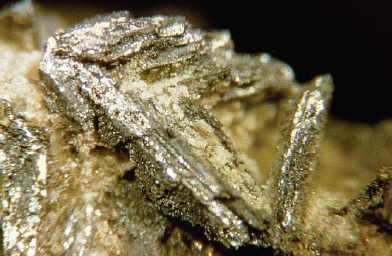Folks,
It surprises many people that the foundation metal of almost all solder alloys is tin. Alloy elements such as lead, silver, copper, indium, etc., are extremely important, as they lower the solder melting temperature below tin’s relatively high 232C and often improve wetting and other process or performance properties.
IMAGE: Bismuth Metal (Source Indium Corporation)
As an example, tin-bismuth near-eutectic solders have a melting range around 140C with a processing temperature of about 170°C, putting tin-bismuth solders 50°C or so below most common lead-free solders such as SAC305. A while ago, I posted on tin-bismuth solders, asking if their time has come. This post generated follow-on questions that were answered in a second post.
iNEMI predicts that low-temperature solders, such as these tin-bismuth solders, may become main stream as soon as 2017. In light of this situation, my colleague and friend, Dr. Ning-Cheng Lee, is presenting a workshop on “Properties and Applications of Low Temperature Solders” at SMTAI on September 29, from 8:30-12 noon in room 54.
The course objectives are:
Since the dawn of the electronic industry, the soldering process has encompassed mainly component manufacturing and printed circuit board assembly, with a hierarchic solder melting range. Components are made using solder alloys with melting temperatures around 300°C, which will not melt in the subsequent PCB assembly process, where the solders typically melt around 200°C. Low-temperature solders, with melting temperatures less than 170°C, are currently used mainly for niche applications. However, the iNEMI roadmap predicts low-temperature soldering to become a mainstream processes by 2017. Low-temperature soldering is greatly desired for assemblies such as heat-sensitive devices, systems with more hierarchic levels, parts with significant differences in their coefficients of thermal expansion, components exhibiting severe thermal warpage, or products with highly miniaturized design. This course will cover several varieties of low-temperature solders with an emphasis on lead-free alloys, their physical, mechanical, and soldering properties, and the applications involved with those alloys.
And the topics covered will be:
· Design of low-temperature solder alloys
· Indium-bearing solder systems and their properties
· Bismuth-bearing solder systems and their properties
· Recent development in bismuth-bearing low-temperature solder alloys
· Mechanisms of reliability enhancement of new bismuth-bearing solder alloys
· Applications of low-temperature solders
Be sure to add this workshop to your list of things to do at SMTAI.
Cheers,
Dr. Ron




